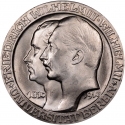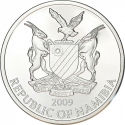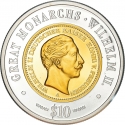You are about to finish your registration. Please check your mailbox (including spam folder). There should be a letter with a confirmation link. Check setting to make sure that your e-mail address is correct.
Send letter againDescription
German East Africa (German: Deutsch-Ostafrika) (GEA) was a German colony in the African Great Lakes region, which included present-day Burundi, Rwanda, and the mainland part of Tanzania (formerly known as Tanganyika). GEA's area was 994,996 square kilometres (384,170 sq mi), which was nearly three times the area of present-day Germany, and double the area of metropolitan Germany then.
The colony was organised when the German military was asked in the late 1880s to put down a revolt against the activities of the German East Africa Company. It ended with Imperial Germany's defeat in World War I. Ultimately, GEA was divided between Britain, Belgium and Portugal and was reorganised as a mandate of the League of Nations.
Obverse
_Rupie_2/0_BC-1894_AD_10.03.2024_22.13-60.jpg)
|
Depicts an effigy of Emperor William II facing left surrounded by his title in Latin. On his head, Wilhelm II wears a detailed Prussian Eagle helmet, which was worn as a parade helmet by the cavalry regiments Gardes du Corps and the Garde Cuirassier Regiment from 1890 onwards. It is decorated with the Prussian Garde Star and the crowned eagle. GUILELMUS II IMPERATOR |
|---|---|
Reverse
_Rupie_2/0_BC-1894_AD_10.03.2024_22.13_01-60.jpg)
|
Depicts the coat of arms of the German East Africa Company (a striding lion in front of a palm tree) with the date at the bottom, surrounded by the inscription in German "German East Africa Company" and face value. DEUTSCH-OSTAFRIKANISCHE GESELLSCHAFT |
| Edge |
_Rupie_2/0_BC-1894_AD_10.03.2024_22.13.jpg)
_Rupie_2/0_BC-1894_AD_10.03.2024_22.13_01.jpg)
_Rupie_0.25/1891-1901_10.03.2024_22.19-125.jpg)
_Rupie_0.25/1891-1901_10.03.2024_22.19_01-125.jpg)



